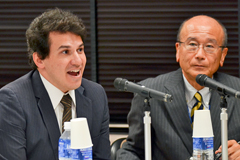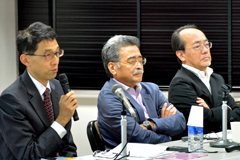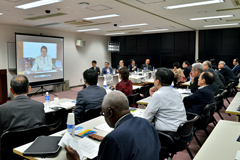Book Launch Event Held on Applying the Land Readjustment Expertise of Japan to Solve Urban Problems Worldwide
2018.11.06
On October 18, 2018, JICA Research Institute (JICA-RI) held a seminar to commemorate the publication of the book “Land Readjustment: Solving Urban Problems Through Innovative Approach” which compiles examples of land readjustment practices in Japan and the world.
As the economies of developing countries grow at a rapid pace, problems such as populations concentrating in cities, insufficient infrastructure, more slums, and environmental pollution have been progressing. Land readjustment is gaining attention as a means for solving these problems. For over 35 years, JICA has been conducting training programs on institutions of urban development, particularly land readjustment, in Japan for those in charge of urban planning in developing countries.
For the opening remarks, JICA-RI Director Izumi Ohno spoke about the significance of this publication. She commented that, “This book is an accomplishment that only JICA could offer in terms of introducing Japanese knowledge and many practical cases all over the world through the network built by the training programs of JICA.”
The seminar then kicked off with one of the editors of the book, JICA Senior Adviser Takeo Ochi, presenting a summary of its contents. He explained that Chapter 1 contains the concept of land readjustment in Japan, Chapter 2 is about land readjustment and post-disaster reconstruction in Japan, Chapter 3 presents international experiences of land readjustment, and Chapter 4 describes JICA technical cooperation and the global dissemination of land readjustment. He said that the book presents cases from as many as 19 countries and regions in addition to Japan. He ended his presentation by saying that a global network of experts has now been established on the topic of land readjustment.

Felipe Francisco de Souza (left) and Takeo Ochi, editors of the book
Next was a panel discussion in which four experts gave presentations of the topic of “How land readjustment can be used as an effective tool to solve the world’s urban land issues.”
The first was the author of Chapter 1 and editor of the book, Felipe Francisco de Souza, who was an alumnus of a JICA training course on land readjustment in 2005. In his presentation about the diversity and characteristics of land readjustment efforts carried out in different countries, he stated that the purposes and challenges of land readjustment differ widely from country to country. Understanding these purposes and challenges therefore requires wide perceptions on various aspects of how land readjustment should be, including the degree of stakeholders’ participation, and how all stakeholders including landowners and public institutions will share the benefits of land readjustment.
Nihon University Professor Takayuki Kishii, also president of the Institute of Behavioral Sciences, then pointed out that, with the assumption that rapid population concentration is the root of urban problems, the creation of rules for distributing costs and benefits of development is important, whether land readjustment is carried by private enterprises or by the public sector. He also presented a case of improved productivity through land readjustment for smaller pieces of agricultural land which farm equipment cannot enter, and a case in which land on either side of a canal is developed at the same time as maintenance performed on the canal.

From left, Yukihisa Tokunaga, Hidetsugu Kobayashi and Takayuki Kishii
Hokkaido University Professor Emeritus Hidetsugu Kobayashi, also chairman of the Japan Society of Urban and Regional Planners, then gave a presentation in which he used Medellin, the second largest city in Colombia, as an example of how land readjustment can be utilized to solve poverty issues. As he described revolutionary urban planning in slums illegally settled by the poor, involving urban infrastructure upgrades such as parks and libraries as well as public transportation systems such as cable cars and railroads, he emphasized that it is essential to have the perspective of socially inclusive urban planning in order to solve urban problems.
Yukihisa Tokunaga, deputy director general for Engineering Affairs of the Ministry of Land, Infrastructure, Transport and Tourism (City Bureau), then shared the characteristics of Japanese land readjustment as well as some practical examples. He pointed out that in order to spread this expertise from Japan to countries around the world, we need to apply the advantages of the Japanese framework according to local circumstances rather than simply exporting the Japanese style as it is.
There were also video messages about practical land readjustment from three countries that had participated in JICA training, Nepal, Bhutan, and Costa Rica. The messages emphasized that land readjustment initiatives are implemented throughout the world. Floor discussions then proceeded with an even more diverse offering of perspectives, including the question of “What is the significance of Japan being involved in urban planning in developing countries?” to which Ochi replied “Land readjustment is effective as a tool in the fight against poverty” and Kishii added, “Supporting land readjustment in developing countries benefits us by allowing us to notice perspectives which we could never see only in Japan.”

There were video messages about practical land readjustment from three countries that had participated in JICA training
Finally, another editor of the book, JICA-RI Senior Research Adviser Akio Hosono, came up to deliver the closing remarks. He concluded the seminar by emphasizing that the land readjustment approach is effective towards achieving goal 11 of the Sustainable Development Goals (SDGs), “Sustainable cities and communities.”

事業事前評価表(地球規模課題対応国際科学技術協力(SATREPS)).国際協力機構 地球環境部 . 防災第一チーム. 1.案件名.国 名: フィリピン共和国.

事業事前評価表(地球規模課題対応国際科学技術協力(SATREPS)).国際協力機構 地球環境部 . 防災第一チーム. 1.案件名.国 名: フィリピン共和国.

事業事前評価表(地球規模課題対応国際科学技術協力(SATREPS)).国際協力機構 地球環境部 . 防災第一チーム. 1.案件名.国 名: フィリピン共和国.

事業事前評価表(地球規模課題対応国際科学技術協力(SATREPS)).国際協力機構 地球環境部 . 防災第一チーム. 1.案件名.国 名: フィリピン共和国.

事業事前評価表(地球規模課題対応国際科学技術協力(SATREPS)).国際協力機構 地球環境部 . 防災第一チーム. 1.案件名.国 名: フィリピン共和国.
scroll